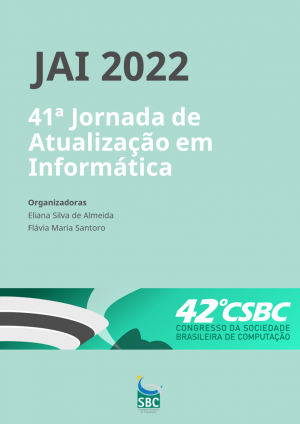Jornada de Atualização em Informática 2022
Palavras-chave:
CSBC 2022, JAI 2022Sinopse
A Jornada de Atualização em Informática (JAI) é um evento que se tornou referência na apresentação de tópicos relevantes para a pesquisa e desenvolvimento dentro do Congresso da Sociedade Brasileira de computação. A JAI vem contribuindo de forma significativa com a disseminação de conhecimento de ponta para os alunos, profissionais e pesquisadores em Computação no Brasil. Em sua 41ª edição, são tratados os temas processamento de linguagem natural e aprendizagem profunda; estratégias ágeis em projetos de PD&I; big data e economia circular; e blockchain. O Capítulo 1 (Processamento de Linguagem Natural via Aprendizagem Profunda) apresenta como técnicas de Aprendizagem Profunda podem ser utilizadas na resolução de tarefas de Processamento de Linguagem Natural (PLN), tais como como Classificação e Sumarização de Sentenças, visando o benefício do poder computacional disponível atualmente e da baixa necessidade de engenharia de fatures na utilização destes modelos. O Capítulo 2 (Estratégias Ágeis Aplicadas à Projetos de PD&I: Da Teoria à Prática) discute os principais desafios, conceitos, relatos e estudos de caso da adoção de estratégias ágeis, em particular o framework Scrum, em pesquisa científica voltada para produção de inovação tecnológica. O Capítulo 3 (Big Data e Tecnologias Digitais Aplicadas à Economia Circular: Oportunidades para Cadeias Produtivas mais Sustentáveis) mostra como big data e as tecnologias digitais, tais como internet das coisas, computação em nuvem e blockchain, desempenham um papel chave na economia circular, como atendem às necessidades desses modelos de negócio no contexto, contribuindo para os desafios atuais de sustentabilidade. O Capítulo 4 (Visitando na teoria e na prática o Cartesi RollUps: para além das limitações da Blockchain, uma solução de futuro para aplicativos descentralizados) trata de uma tecnologia promissora - o Cartesi Rollups - que é capaz de alçar Blockchain ao status de padrão das aplicações na internet do futuro, minimizando suas limitações de escalabilidade.
Capítulos
-
1. Processamento de Linguagem Natural via Aprendizagem Profunda
-
2. Estratégias ágeis aplicadas à projetos de PD&I: da teoria à prática
-
3. Big Data e Tecnologias Digitais Aplicadas à Economia Circular: Oportunidades para Cadeias Produtivas mais Sustentáveis
-
4. Visitando na teoria e na prática o Cartesi RollUps: para além das limitações da Blockchain, uma solução de futuro para aplicativos descentralizados
Downloads

Downloads
Data de publicação
Licença

Este trabalho está licenciado sob uma licença Creative Commons Attribution-NonCommercial 4.0 International License.


